technical data JEEP RENEGADE 2018 Owner handbook (in English)
[x] Cancel search | Manufacturer: JEEP, Model Year: 2018, Model line: RENEGADE, Model: JEEP RENEGADE 2018Pages: 356, PDF Size: 6.11 MB
Page 3 of 356
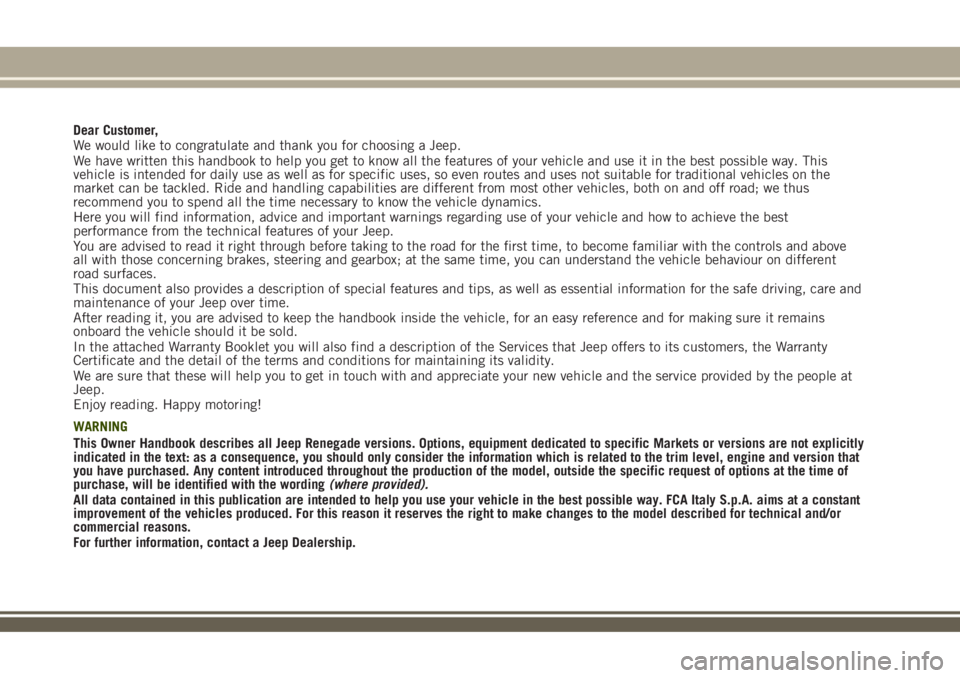
Dear Customer,
We would like to congratulate and thank you for choosing a Jeep.
We have written this handbook to help you get to know all the features of your vehicle and use it in the best possible way. This
vehicle is intended for daily use as well as for specific uses, so even routes and uses not suitable for traditional vehicles on the
market can be tackled. Ride and handling capabilities are different from most other vehicles, both on and off road; we thus
recommend you to spend all the time necessary to know the vehicle dynamics.
Here you will find information, advice and important warnings regarding use of your vehicle and how to achieve the best
performance from the technical features of your Jeep.
You are advised to read it right through before taking to the road for the first time, to become familiar with the controls and above
all with those concerning brakes, steering and gearbox; at the same time, you can understand the vehicle behaviour on different
road surfaces.
This document also provides a description of special features and tips, as well as essential information for the safe driving, care and
maintenance of your Jeep over time.
After reading it, you are advised to keep the handbook inside the vehicle, for an easy reference and for making sure it remains
onboard the vehicle should it be sold.
In the attached Warranty Booklet you will also find a description of the Services that Jeep offers to its customers, the Warranty
Certificate and the detail of the terms and conditions for maintaining its validity.
We are sure that these will help you to get in touch with and appreciate your new vehicle and the service provided by the people at
Jeep.
Enjoy reading. Happy motoring!
WARNING
This Owner Handbook describes all Jeep Renegade versions. Options, equipment dedicated to specific Markets or versions are not explicitly
indicated in the text: as a consequence, you should only consider the information which is related to the trim level, engine and version that
you have purchased. Any content introduced throughout the production of the model, outside the specific request of options at the time of
purchase, will be identified with the wording(where provided).
All data contained in this publication are intended to help you use your vehicle in the best possible way. FCA Italy S.p.A. aims at a constant
improvement of the vehicles produced. For this reason it reserves the right to make changes to the model described for technical and/or
commercial reasons.
For further information, contact a Jeep Dealership.
Page 11 of 356

GRAPHICAL INDEX
GETTING TO KNOW YOUR CAR
KNOWING THE INSTRUMENT PANEL
SAFETY
STARTING AND DRIVING
IN AN EMERGENCY
SERVICING AND MAINTENANCE
TECHNICAL DATA
MULTIMEDIA
INDEX
Page 77 of 356
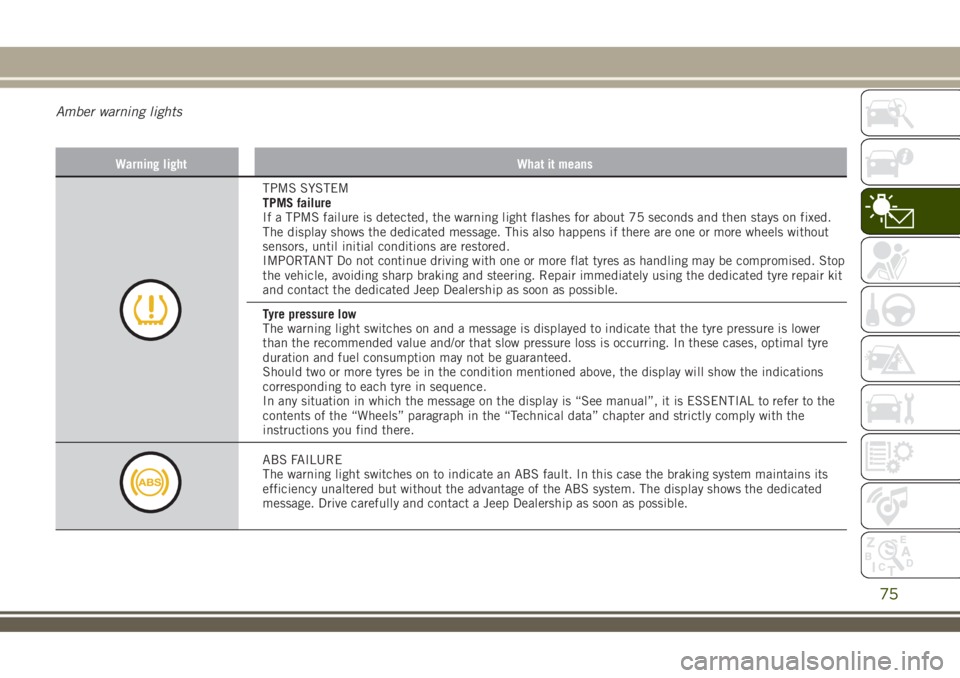
Amber warning lights
Warning light What it means
TPMS SYSTEM
TPMS failure
If a TPMS failure is detected, the warning light flashes for about 75 seconds and then stays on fixed.
The display shows the dedicated message. This also happens if there are one or more wheels without
sensors, until initial conditions are restored.
IMPORTANT Do not continue driving with one or more flat tyres as handling may be compromised. Stop
the vehicle, avoiding sharp braking and steering. Repair immediately using the dedicated tyre repair kit
and contact the dedicated Jeep Dealership as soon as possible.
Tyre pressure low
The warning light switches on and a message is displayed to indicate that the tyre pressure is lower
than the recommended value and/or that slow pressure loss is occurring. In these cases, optimal tyre
duration and fuel consumption may not be guaranteed.
Should two or more tyres be in the condition mentioned above, the display will show the indications
corresponding to each tyre in sequence.
In any situation in which the message on the display is “See manual”, it is ESSENTIAL to refer to the
contents of the “Wheels” paragraph in the “Technical data” chapter and strictly comply with the
instructions you find there.
ABS FAILURE
The warning light switches on to indicate an ABS fault. In this case the braking system maintains its
efficiency unaltered but without the advantage of the ABS system. The display shows the dedicated
message. Drive carefully and contact a Jeep Dealership as soon as possible.
75
Page 218 of 356
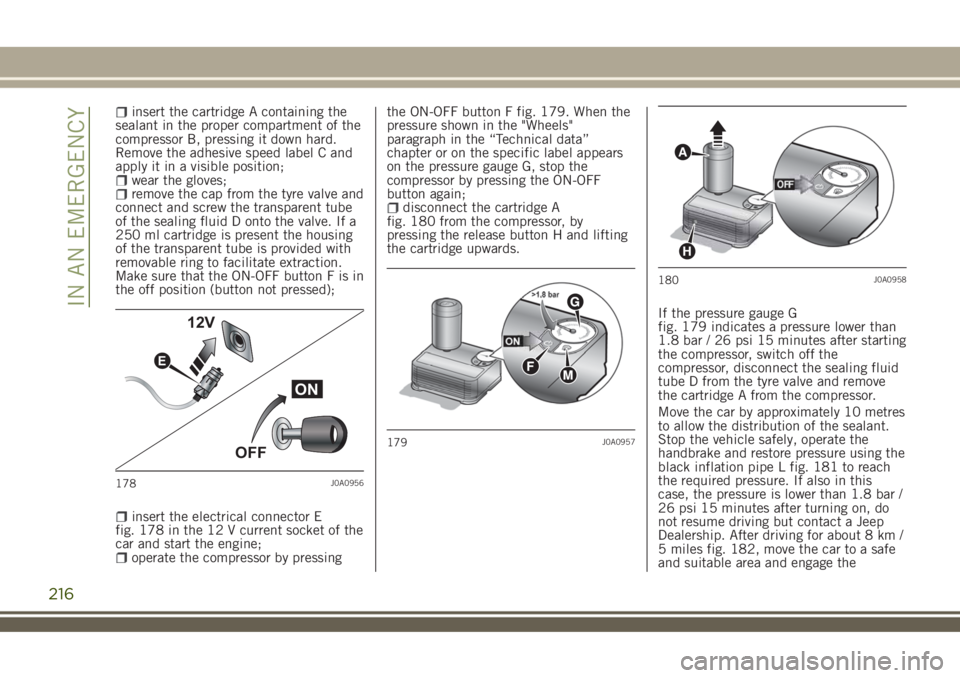
insert the cartridge A containing the
sealant in the proper compartment of the
compressor B, pressing it down hard.
Remove the adhesive speed label C and
apply it in a visible position;
wear the gloves;remove the cap from the tyre valve and
connect and screw the transparent tube
of the sealing fluid D onto the valve. If a
250 ml cartridge is present the housing
of the transparent tube is provided with
removable ring to facilitate extraction.
Make sure that the ON-OFF button F is in
the off position (button not pressed);
insert the electrical connector E
fig. 178 in the 12 V current socket of the
car and start the engine;
operate the compressor by pressingthe ON-OFF button F fig. 179. When the
pressure shown in the "Wheels"
paragraph in the “Technical data”
chapter or on the specific label appears
on the pressure gauge G, stop the
compressor by pressing the ON-OFF
button again;
disconnect the cartridge A
fig. 180 from the compressor, by
pressing the release button H and lifting
the cartridge upwards.
If the pressure gauge G
fig. 179 indicates a pressure lower than
1.8 bar / 26 psi 15 minutes after starting
the compressor, switch off the
compressor, disconnect the sealing fluid
tube D from the tyre valve and remove
the cartridge A from the compressor.
Move the car by approximately 10 metres
to allow the distribution of the sealant.
Stop the vehicle safely, operate the
handbrake and restore pressure using the
black inflation pipe L fig. 181 to reach
the required pressure. If also in this
case, the pressure is lower than 1.8 bar /
26 psi 15 minutes after turning on, do
not resume driving but contact a Jeep
Dealership. After driving for about 8 km /
5 miles fig. 182, move the car to a safe
and suitable area and engage the
ON
OFF 12V
E
178J0A0956
179J0A0957
A
H
180J0A0958
216
IN AN EMERGENCY
Page 261 of 356
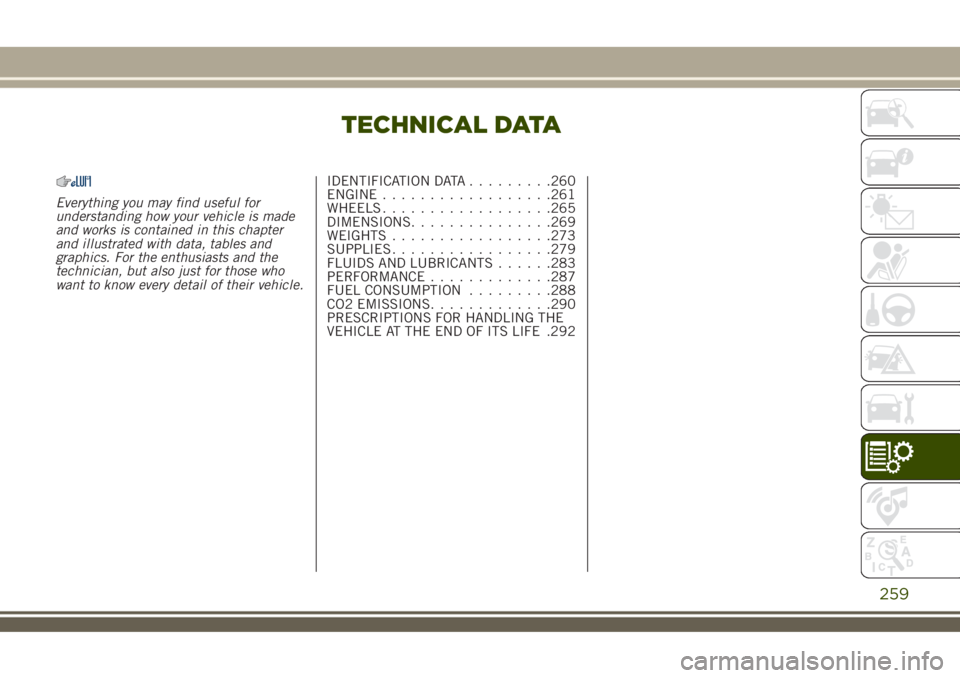
TECHNICAL DATA
Everything you may find useful for
understanding how your vehicle is made
and works is contained in this chapter
and illustrated with data, tables and
graphics. For the enthusiasts and the
technician, but also just for those who
want to know every detail of their vehicle.IDENTIFICATION DATA.........260
ENGINE..................261
WHEELS..................265
DIMENSIONS...............269
WEIGHTS.................273
SUPPLIES.................279
FLUIDS AND LUBRICANTS......283
PERFORMANCE.............287
FUEL CONSUMPTION.........288
CO2 EMISSIONS.............290
PRESCRIPTIONS FOR HANDLING THE
VEHICLE AT THE END OF ITS LIFE .292
259
Page 262 of 356
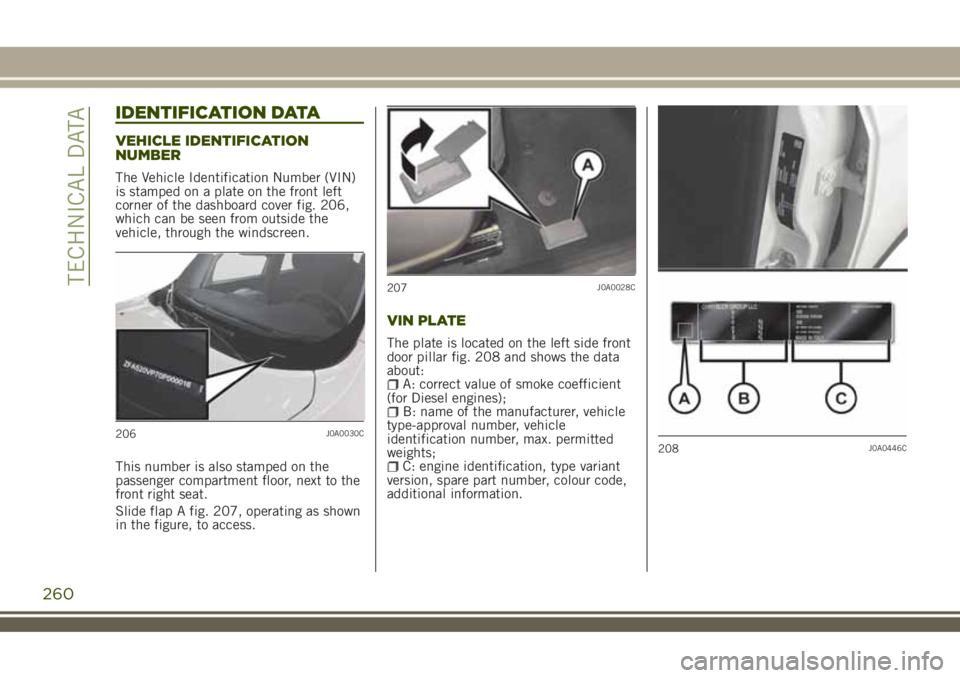
IDENTIFICATION DATA
VEHICLE IDENTIFICATION
NUMBER
The Vehicle Identification Number (VIN)
is stamped on a plate on the front left
corner of the dashboard cover fig. 206,
which can be seen from outside the
vehicle, through the windscreen.
This number is also stamped on the
passenger compartment floor, next to the
front right seat.
Slide flap A fig. 207, operating as shown
in the figure, to access.
VIN PLATE
The plate is located on the left side front
door pillar fig. 208 and shows the data
about:
A: correct value of smoke coefficient
(for Diesel engines);
B: name of the manufacturer, vehicle
type-approval number, vehicle
identification number, max. permitted
weights;
C: engine identification, type variant
version, spare part number, colour code,
additional information.
206J0A0030C
207J0A0028C
208J0A0446C
260
TECHNICAL DATA
Page 264 of 356
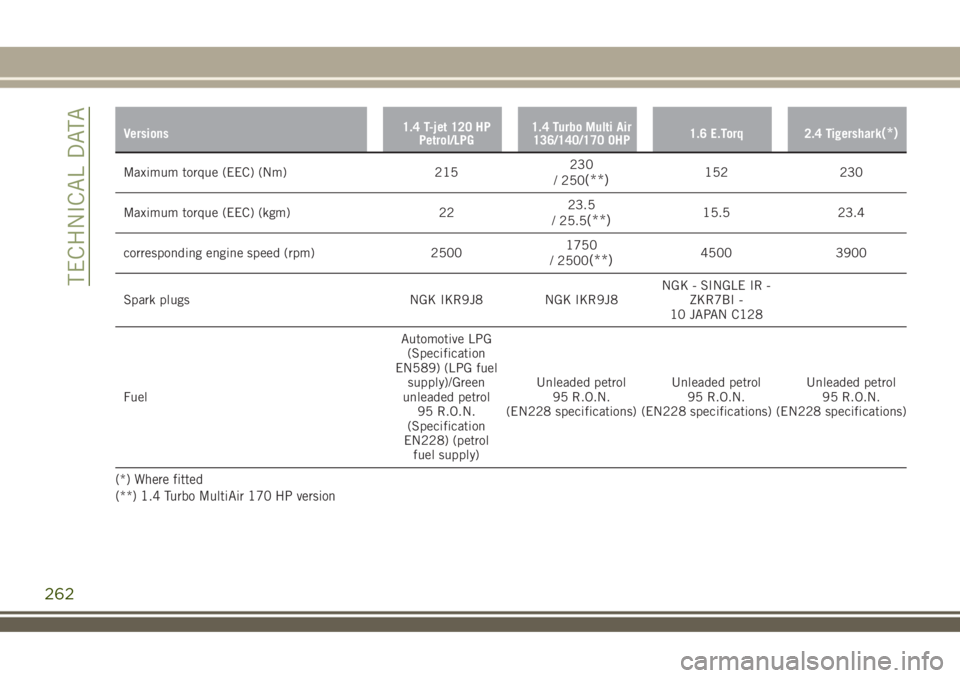
Versions1.4 T-jet 120 HP
Petrol/LPG1.4 Turbo Multi Air
136/140/170 OHP1.6 E.Torq 2.4 Tigershark(*)
Maximum torque (EEC) (Nm) 215230
/ 250(**)152 230
Maximum torque (EEC) (kgm) 2223.5
/ 25.5
(**)15.5 23.4
corresponding engine speed (rpm) 25001750
/ 2500
(**)4500 3900
Spark plugs NGK IKR9J8 NGK IKR9J8NGK - SINGLE IR -
ZKR7BI -
10 JAPAN C128
FuelAutomotive LPG
(Specification
EN589) (LPG fuel
supply)/Green
unleaded petrol
95 R.O.N.
(Specification
EN228) (petrol
fuel supply)Unleaded petrol
95 R.O.N.
(EN228 specifications)Unleaded petrol
95 R.O.N.
(EN228 specifications)Unleaded petrol
95 R.O.N.
(EN228 specifications)
(*) Where fitted
(**) 1.4 Turbo MultiAir 170 HP version
262
TECHNICAL DATA
Page 266 of 356

Versions 2.0 16V Multijet 120 HP 2.0 16V Multijet 140 HP 2.0 16V Multijet 170 HP
Engine code 5526308755263087 / 55263088(*)55263088
Cycle Diesel Diesel Diesel
Number and position of cylinders 4 in line 4 in line 4 in line
Piston bore and stroke (mm) 83 × 90.4 83 × 90.4 83 × 90.4
Total displacement (cm³) 1956 1956 1956
Compression ratio 16.5 16.5 16.5
Maximum power (EC) (kW) 88 103 125
Maximum power (EEC) (HP) 120 140 170
corresponding engine speed (rpm) 4000
3750 / 4000
(*)3750
Maximum torque (EC) (Nm) 320 350 350
Maximum torque (EC) (kgm) 32.6 35.7 35.7
corresponding engine speed (rpm) 1250
1500 / 1750
(*)1750
FuelDiesel for motor vehicles
(EN590 Specification)Diesel for motor vehicles
(EN590 Specification)Diesel for motor vehicles
(EN590 Specification)
(*) Versions with automatic transmission
264
TECHNICAL DATA
Page 268 of 356
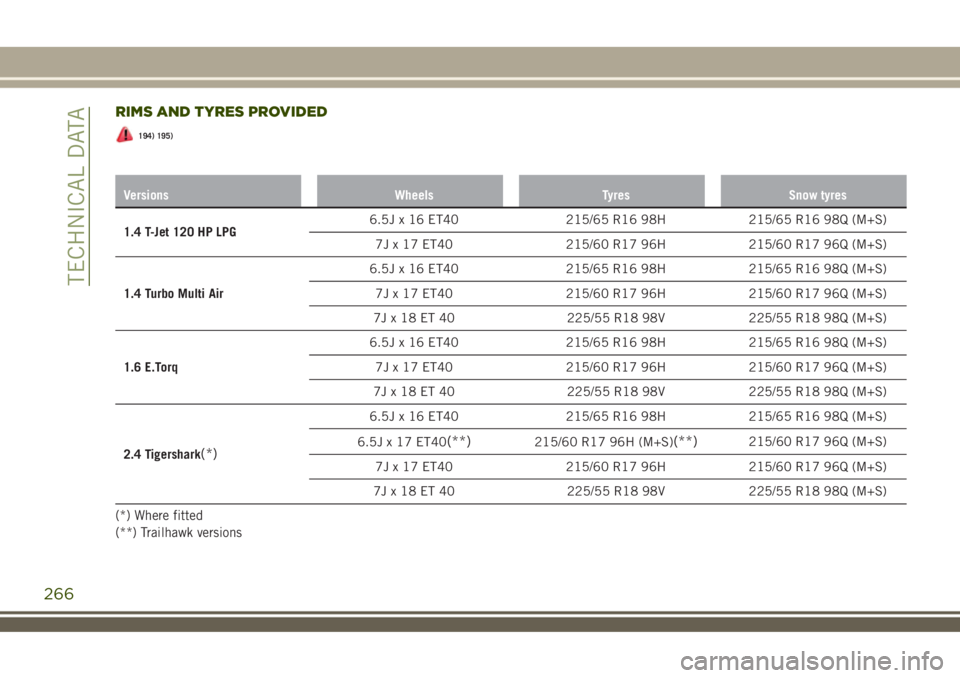
RIMS AND TYRES PROVIDED
194) 195)
Versions Wheels Tyres Snow tyres
1.4 T-Jet 120 HP LPG6.5J x 16 ET40 215/65 R16 98H 215/65 R16 98Q (M+S)
7J x 17 ET40 215/60 R17 96H 215/60 R17 96Q (M+S)
1.4 Turbo Multi Air6.5J x 16 ET40 215/65 R16 98H 215/65 R16 98Q (M+S)
7J x 17 ET40 215/60 R17 96H 215/60 R17 96Q (M+S)
7J x 18 ET 40 225/55 R18 98V 225/55 R18 98Q (M+S)
1.6 E.Torq6.5J x 16 ET40 215/65 R16 98H 215/65 R16 98Q (M+S)
7J x 17 ET40 215/60 R17 96H 215/60 R17 96Q (M+S)
7J x 18 ET 40 225/55 R18 98V 225/55 R18 98Q (M+S)
2.4 Tigershark
(*)
6.5J x 16 ET40 215/65 R16 98H 215/65 R16 98Q (M+S)
6.5J x 17 ET40
(**)215/60 R17 96H (M+S)(**)215/60 R17 96Q (M+S)
7J x 17 ET40 215/60 R17 96H 215/60 R17 96Q (M+S)
7J x 18 ET 40 225/55 R18 98V 225/55 R18 98Q (M+S)
(*) Where fitted
(**) Trailhawk versions
266
TECHNICAL DATA
Page 270 of 356
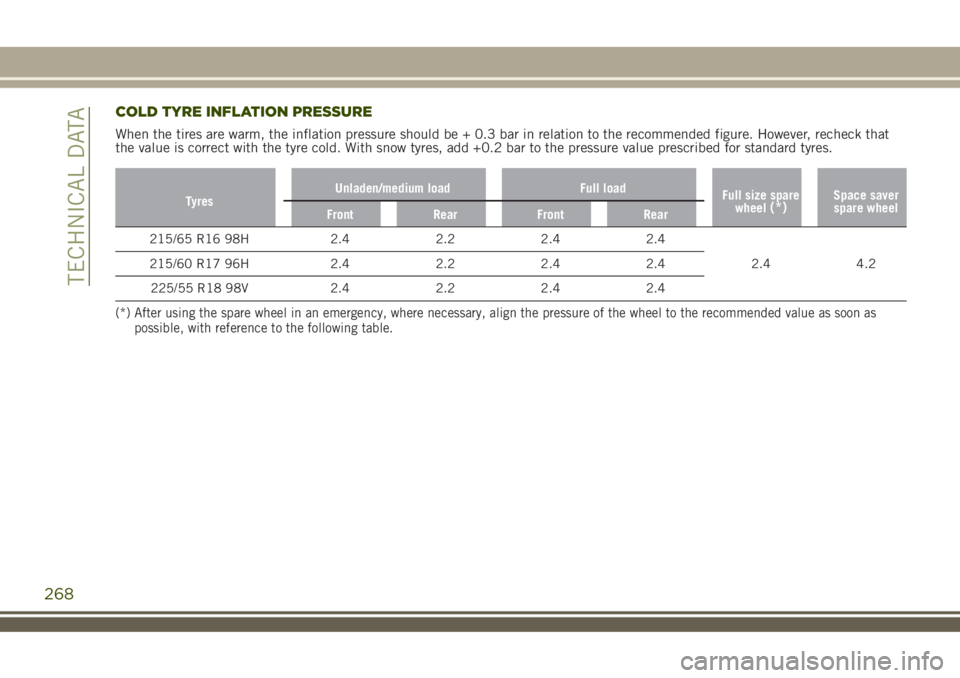
COLD TYRE INFLATION PRESSURE
When the tires are warm, the inflation pressure should be + 0.3 bar in relation to the recommended figure. However, recheck that
the value is correct with the tyre cold. With snow tyres, add +0.2 bar to the pressure value prescribed for standard tyres.
TyresUnladen/medium load Full load
Full size spare
wheel(*)Space saver
spare wheel
Front Rear Front Rear
215/65 R16 98H 2.4 2.2 2.4 2.4
2.4 4.2 215/60 R17 96H 2.4 2.2 2.4 2.4
225/55 R18 98V 2.4 2.2 2.4 2.4
(*) After using the spare wheel in an emergency, where necessary, align the pressure of the wheel to the recommended value as soon as
possible, with reference to the following table.
268
TECHNICAL DATA